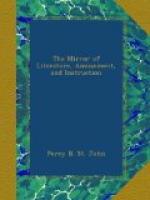Foreign naturalists have been much occupied of late with the mole. From the recently published observations of one of them, M. Flourens, it appears that this animal, as its organization indicates, is, if not exclusively, at least, essentially, carnivorous. It very soon dies if only roots be given to it; and if it destroy so many roots of vegetables, it is not for the purpose of eating them, but to seek among them for worms, insects, and particularly for the larvae of insects which harbour there. They may be kept alive for a long time upon any animal food. Ten or twelve hours are nearly the longest time they can live without food. Like all animals which feed upon blood and flesh, the mole is always very thirsty.—Monthly Mag.
* * * * *
CLIMATE OF THE CAPE OF GOOD HOPE.
The climate of the British dominions in the south of Africa is one of the finest in the world. The average height of the barometer is above thirty inches, and the average summer heat at noon is about 78 deg. It resembles the climate of Italy, but is rather warmer and dryer. It is so dry, that draining is little required for the ground: on the contrary, it is necessary to retain moisture as much as possible, and even irrigation is desirable, more especially from the grasses. The mountains abound in springs, but the supply of water is scanty and precarious, from the want of energy and skill in procuring that essential article. Such a scarcity frequently arises, that the cattle perish from thirst, and the people themselves are in danger of a similar fate.—Gill’s Repository.
Sea Pens.
[Illustration: Sea Pens.]
The cuts represent two fine Sea Pens—Silver and Red, with Sections.
Of all the Sea Pens yet known, the first is one of the largest and most curious in its appearance; being of a beautiful silvery white, elegantly straited on each of the feather-like processes, with lines or streaks of the deepest black. It is extremely rare, and is a native of the Indian Seas. The accompanying Engraving is copied from a fine specimen in the British Museum.
* * * * *
THE RED SEA-PEN IS
Of a very beautiful appearance, and is found on the British coast. The animal consists of a flattened stem, or body, which is furnished with an internal bone, and dilates into an expanded part, consisting of several pinnae, or lateral branches, which are divided on their inner edges into a number of tubular processes, through each of which is protruded a part of the animal, resembling the head of a hydra or polype; the whole animal may, therefore, be considered as a very compound or ramified union of polypi, the bodies of which are contained in the naked part or stem, and from thence ramify into a vast number of processes, each furnished with its particular head. The animal emits a very strong phosphoric light, and it is even so luminous, that it is no uncommon circumstance for the fishermen to see the fish which happen to be swimming near it merely by the light of the Pens. Its colour is a bright red crimson, and the general size that of the figure.




